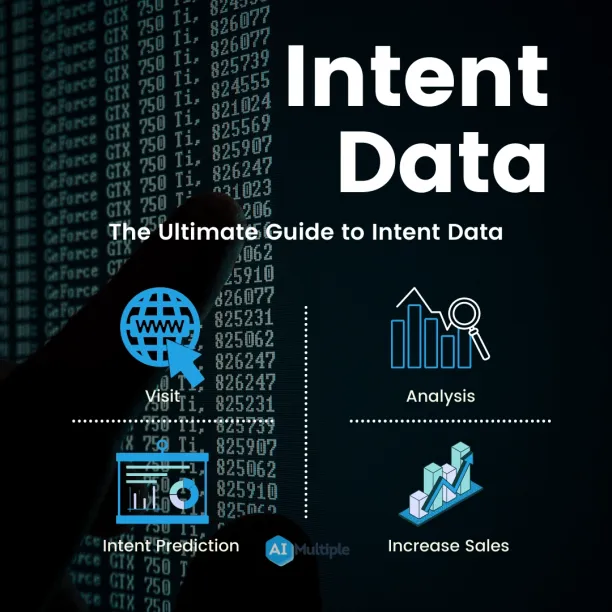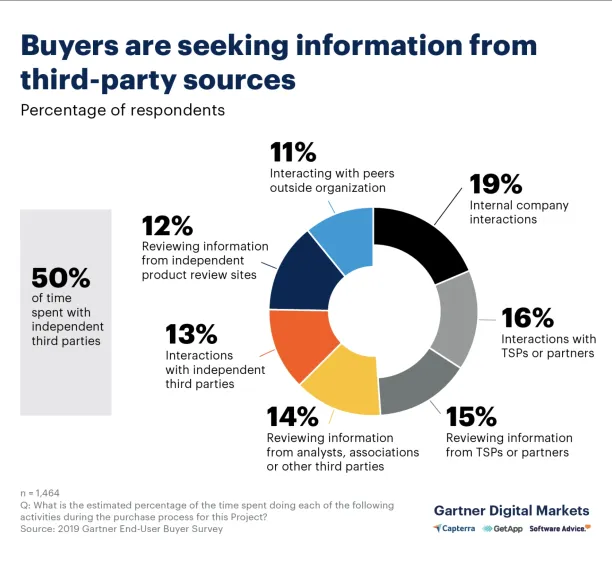The Ultimate Guide to Intent Data: Benefits and How-To in 2024

Almost every business (B2C or B2B) reaches out to users, mentioning their products. Most users don’t respond to these messages or ads because it is not the right time for them to buy that product. I would like to get the ad for ordering food when I am hungry and the ad for a B2B software when I am thinking about buying a solution in that category. Intent data allows companies to reach customers at the right time.
Every click, comment, and like that we leave on the Internet leaves a data-trace. It is possible to use, process, and report these data to identify users’ intent. Intent data can improve the marketing of both B2B and B2C brands.
What is intent data?
Intent data covers the purchasing intent of individuals or companies. This intent is determined by individuals’ or companies’ online or offline behavior. It allows vendors to determine which potential customers to reach and what messages to communicate to them.
Many of us use online platforms for shopping, and sometimes we just click and look at a product. Then, when we log in to another site, we encounter an advertisement for that product on the side. That’s an example of a company using our intent data to send ads to us.
Intent data can cover users’ interests and could predict users’ intent to complete actions other than buying (e.g. signing up to a newsletter etc.). However, the most common use of intent data is to estimate buyer intent, and therefore buyer intent data and intent data are used to mean the same thing in most cases.
What is B2B intent data?
Intent data is a fresh concept for B2B sales. In B2B organizations, intent data is mainly used to identify potential customers. Companies can use intent data also for sales enablement, ABM, and digital marketing assistance. For example, most B2B companies do some form of cold outreach via email or Linkedin. Using intent data makes this outreach more targeted, increasing conversion rates.
Where do companies get intent data from?
Companies’ own digital properties generate data on buyer intent but there are other sources as well and they can be used to improve a company’s intent estimates:
- First-party intent data is generated on a company’s own digital properties. It can be detailed but it is limited to a company’s existing audience
- Second-party intent data is first-party intent data obtained via a third-party provider. For example, a media company can shares its first-party intent data with other companies. From the perspective of other companies, this would be second-party intent data
- Third-party intent data represents a global dataset purchased from data providers
Why is intent data important?
It drives sales and businesses are seeing benefits. As a result, most businesses are investing in intent data.
Gartner claims that more than 70% of B2B buyers will increase their use of third-party intent data by the end of 2022. As companies aim to expand their audience, they need to rely on second and third-party intent data for better targeting.

According to a study conducted by intent data provider TrustRadius in 2021, these companies are leveraging intent data:
- 40% of software companies
- 47% of midsize businesses
Gartner’s prediction and TrustRadius’ survey have quite different results but all agree that at least a significant share of companies are benefitting from intent data.
How do businesses collect intent data?
Websites record their user’s activities and it can generate intent data at the IP level as well as through user registration and cookies. IP databases are used to identify the company of the user in case of B2B intent data. Example recorded activities can be:
- Product reviews
- Whitepaper downloads
- Google searches
- Subscription or registration
- Website visits
How to use intent data?
Intent data providers analyze this data and prepare a report or a list of firms you may target. These reports are reviewed by marketing and sales departments so they can be used for:
- Preventing churn: If your customers are regularly checking out your competitors’ websites then it may be good idea to talk to them to understand why they are doing such research
- Upselling: When different divisions or geographic units in one of your customers are researching your category, you can reach out to them to understand if they would like to try your solution. Providing their colleagues as a reference can shorten the sales cycle.
- Improving targeting for outreach efforts/outbound sales
What is outbound sales?
Outbound sales is done via sales reps directly reaching out to potential buyers via email, cold calls or Linkedin et. to promote your brand, product, or service. Outbound sales has a very low success rate because it is hard to determine which companies are suitable for your product and whether they are ready to buy.
- B2B Intent data helps vendors determine which companies are ready to buy
- Firmographics and technographics help vendors determine which companies are suitable for their products.
Who are intent data providers?
There are 2 types of intent data providers:
- Companies that have access to buyer intent information. This includes companies like us or review platforms like TrustRadius
- Companies that aggregate intent data from brands like media companies and industry analysts. Companies like Bombora bring together intent data from many media companies.
The followings are the most frequent activities carried out by intent data providers:
- Gathering of intent data
- Data cleaning & quality assurance
- Prediction of intent with machine learning models or rules based approaches
- Integration of intent data to ABM or CRM tools
To explore the intent data landscape, feel free to check our data-driven lists for

Cem has been the principal analyst at AIMultiple since 2017. AIMultiple informs hundreds of thousands of businesses (as per similarWeb) including 60% of Fortune 500 every month.
Cem's work has been cited by leading global publications including Business Insider, Forbes, Washington Post, global firms like Deloitte, HPE, NGOs like World Economic Forum and supranational organizations like European Commission. You can see more reputable companies and media that referenced AIMultiple.
Throughout his career, Cem served as a tech consultant, tech buyer and tech entrepreneur. He advised businesses on their enterprise software, automation, cloud, AI / ML and other technology related decisions at McKinsey & Company and Altman Solon for more than a decade. He also published a McKinsey report on digitalization.
He led technology strategy and procurement of a telco while reporting to the CEO. He has also led commercial growth of deep tech company Hypatos that reached a 7 digit annual recurring revenue and a 9 digit valuation from 0 within 2 years. Cem's work in Hypatos was covered by leading technology publications like TechCrunch and Business Insider.
Cem regularly speaks at international technology conferences. He graduated from Bogazici University as a computer engineer and holds an MBA from Columbia Business School.
To stay up-to-date on B2B tech & accelerate your enterprise:
Follow on
Comments
Your email address will not be published. All fields are required.